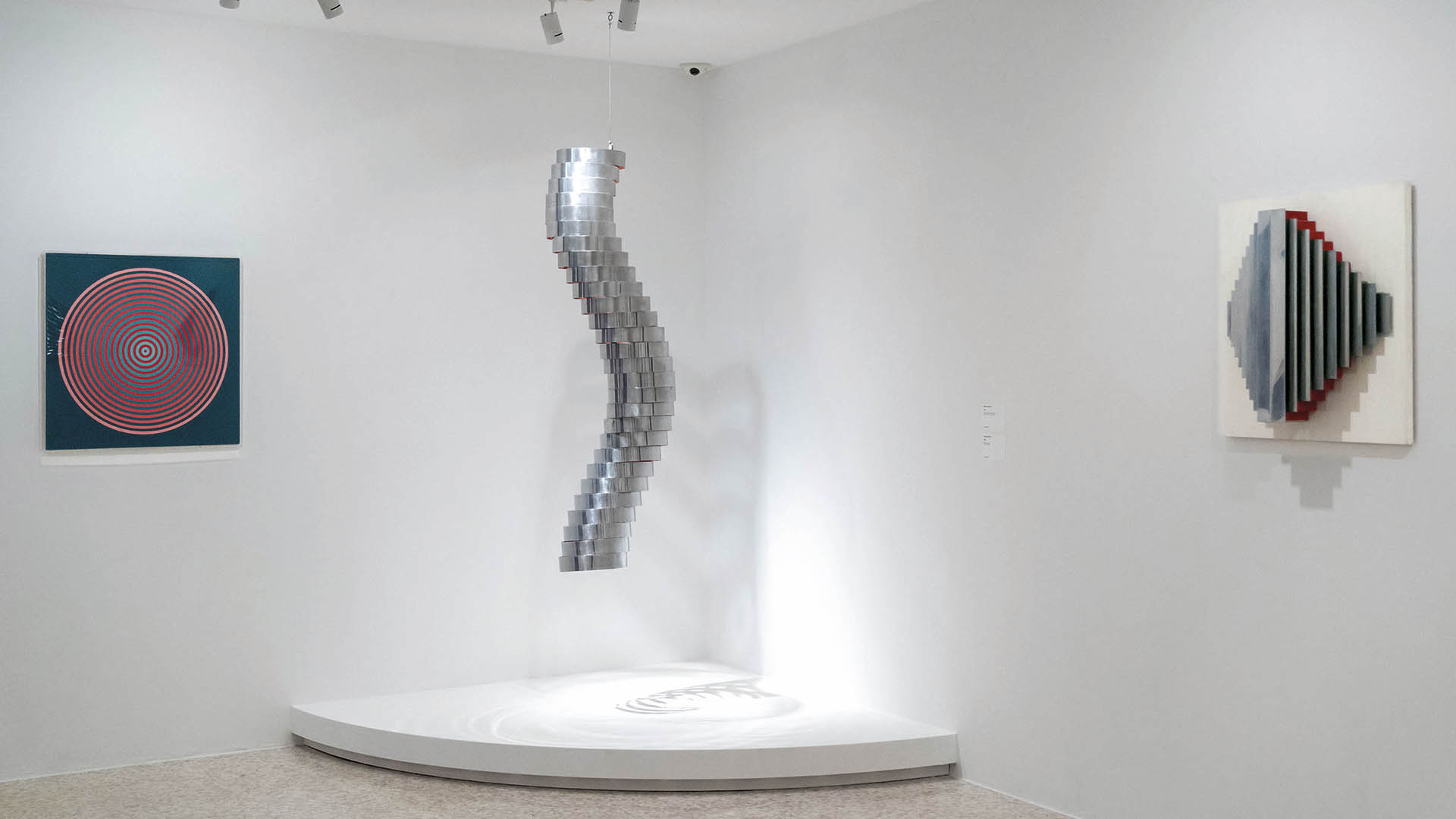

A special interview with a special artist, Marina Apollonio, and a special event celebrating her art at Peggy Guggenheim’s in Venice or, in Apollonio’s words, “at Peggy’s”.
Curiosity, invention, creation, intelligence, passion, and irony build the story of life and art. We listened closely to words on an idea of art that, over the course of time, started from pure avant-garde movement to subversion of existing order and ended up as fluid, modern art culture. “Do I talk too much?”, asked Marina Apollonio. This may sound cliched, I beg you to forgive me, but during this conversation, time felt so abstract, so unlike anything that can be measured. It looked, instead, like the artist’s perpetually moving circles – her creative Heimat. Words enveloped us as we enthusiastically shared story after story. We wished we could go on forever! We wish the same for Apollonio’s art research, a living, breathing body that is still growing. At her latest press conference, the artist was asked whether her exhibition at the Guggenheim Collection was the ‘coming full circle’ of her art expression. Her reply: “Not at all! There are squares, too!”. She then invited to see her art as a process, something that evolves beyond the mechanical ticking of a clock. There is no way to render exhaustively the uniqueness of a conversation with an artist as special in the history of twentieth-century art and as friendly as Marina Apollonio. What we can do is write down what we learned from her and from her art, asking her to guide us into her vital whirlwind of creation.
On to 1968, I had started by research on metal relief a few years earlier, and I had been invited by the Barozzi gallery to produce a personal exhibition. It was in that occasion that I met Peggy Guggenheim again. She had already committed to supporting the Italian avant-garde, and she commissioned my Rilief, which still belongs to the Guggenheim collection, today, and is the starting point of the current exhibition

Let’s start with your father, Umbro Apollonio. What influence, in both personal and professional terms, did he have on you as a child, young woman, and accomplished artist?
Spirit and irony are something I inherited from my father’s side, definitely. Umbro was a professor and art critic, born in Trieste. I was born in Trieste, too, though we left when I was five to follow him in Milan for his new job at Mondadori. We stayed a bit there, and then moved to Venice for his new post as a director of the Biennale Historical Archive, which he held from 1949 to 1972. My father was friends with all the intellectuals of Trieste of the time, from Umberto Sava to Italo Svevo. I have beautiful memories of Trieste, young though I was, I remember all these interesting, bright people, who knew and loved me. Once in Venice, my father had an easy time befriending local artists. They felt understood, and he was always there for them. He once even entertained that painter who thought he did something revolutionary – no oil painting no more, butter painting! We often had Giuseppe Santomaso, Emilio Vedova, Carlo Scarpa, Luigi Nono, and other art personalities in our house. I never dared speak, I just didn’t know how anything I said could interest such important people! I wanted to study art as soon as I could, but my father opposed it. Artists starve! I was sent to boarding school and studied humanities, mostly, and that has been quite a chore for me. He travelled a lot, too, to art events and conferences all around the world. Just a few words on my father. I realize just how essential he was for me, for my education. Not only him, all the people that he was close to, as well.

You met Peggy Guggenheim in 1968. She was one of the first buyers of your art when she acquired your Relief no. 505. How important was it, and has been, for you to meet her?
Peggy Guggenheim was close to my father, it was him who often took me to see her. They were different, though both considered celebrities in their own right. How I loved her house when I was a child! The garden, especially. The tree looked big to me as a child, and it grow even larger since. Peggy was a strong, special person. She was kind with me, but not overly affectionate, and I felt a bit intimidated by her. On to 1968, I had started by research on metal relief a few years earlier, and I had been invited by the Barozzi gallery to produce a personal exhibition. It was in that occasion that I met Peggy Guggenheim again. She had already committed to supporting the Italian avant-garde, and she commissioned my Rilief, which still belongs to the Guggenheim collection, today, and is the starting point of the current exhibition. Meeting her was essential for my career as an artist, because it gave me recognition, the self-confidence I needed, the assurance that I was taking the right path forward, and the strength to keep on going. In fact, my family didn’t believe in my ability much. After school, which I barely made out of, I found work at an architect’s studio. I was in my late teens. My parents called this architect to know how I was doing, they wouldn’t believe me if I told them! My employer reassured them, and told them I was doing great. I loved the job, too. It was more than just houses: I met architects, ceramists, artists…
Your exhibition at the Guggenheim. It almost feels like you’ve gone full circle.
This retrospective is such a gift. It allowed me to relive my own life and reflect on it. Marianna Gelussi, who curated it, has been working with me for years. In 2018, we were producing my exhibition Open Works in Barcelona, and we started thinking how we could produce my next one in a proper museum. We discussed Graz and Zurich, where I already had some pieces on display, but Marianna insisted: “We have to do it at Guggenheim’s!”. I thought: that’s aiming high! Then, Karole Vail called me to participate in the exhibition she was curating, Peggy Guggenheim: The Last Dogaressa. I was surprised. I was honoured. That event set it all in motion, and now there’s a whole art exhibition about me at the Guggenheim. I can’t believe it!

You hate gender distinctions in art: an artist is an artist, whether they’re a man or a woman. Still, though, finding a place in the avant-gardes hasn’t always been easy for women…
Dadamaino, a great artist, was a good friend of mine. We laughed so much together, and especially, we supported one another when, as female artists, we couldn’t find much space on the art scene. When she was excluded from the kinetic art exhibition in Milan, even though she was a friend of Manzoni’s, she was so disappointed. We are talking of the 1960s, women were relegated in the background. Over time, she grew as an artist, participated in the Biennale in 1980, and eventually found her consecration in the art world. We grew distant because her art got more political. She took me to her anarchist gatherings and wanted me to join. I mean, I was a bit wild – what artist isn’t? – they were free and inventive and special… I just wasn’t wild enough. A recent exhibition in Florence also had my art as well as Carla Accardi’s and Dadamaino’s as representatives of the ‘female avant-garde’. I don’t of this as a consecration, nor have I ever believed in feminism as an exclusionary category. I feel quite modern in this belief.
Generally, artists who adhere to kinetic art, concrete art, optical, minimalist, geometric… share an interest in some form of rational thought
What is your definition of art?
Art is a virus. It’s something one has inside. Dadamaino used to say: “We’re artist, we caught this virus as kids, and now we’re stuck with it”. Generally, artists who adhere to kinetic art, concrete art, optical, minimalist, geometric… share an interest in some form of rational thought. Most of them are designers or architects. Today, I see the world of art as a competition: all want to surprise, to be liked at all costs. Back in my time, I was aware that many didn’t like me. My art was pushing it too far. I was aware of the difficulties in being recognized as an artist and of that fact that my art didn’t have a large market at all. It was research, pure research.
You don’t believe in randomness. Nothing is casual, according to you. The rules underpinning your art are logic, rigour, mathematics, building a combination of pure form and motion. How do you create art?
I can’t bring myself to do something unless I study it, and I control it. It needs to have a brain, to be connected rigorously. When I am able to make much starting with little, that’s when I know that I made good art.
What role for perception in your creations?
On exhibition at the Guggenheim, there’s a piece of mine showing a black and white circle with a square within. Bruno Munari loved it. He got it, he understood it immediately. He was a genius, and also wild!
What role for colour, or absence thereof?
Colour has its own shapes, and shaping colour is not what I want in my research. Colour must be pure. The white fluting highlights the reflections of neon colours, while the other create a sort of chromatic spread that is precise, calculated, never random.